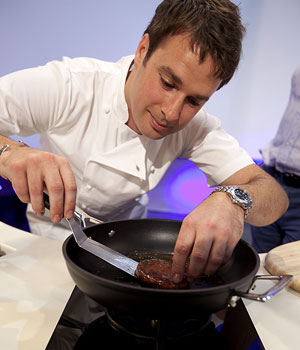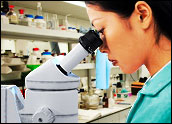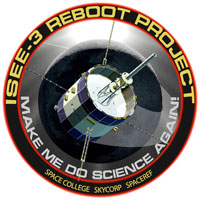
Scientists unveiled the world’s first lab-grown hamburger at a press event in London on Monday, showcasing a patty made from stem cells — a technique that could help alleviate the growing demand for more sustainable beef products.

Mark Post, a scientist at Maastricht University, spent about two years developing the process for making in vitro, or cultured, meat products. Post used stem cells taken harmlessly from the shoulder muscle of cows to create the 5 oz. burger that debuted Monday. Post placed the stem cells in petri dishes, where they multiplied and merged into strands. About 20,000 of the strands were required to create one burger.
On a larger scale, one sample of cells would be enough to produce as much as 20,000 tons of lab-grown meat, Post said. He used the event Monday to highlight the need for alternative meat products, noting that global meat production is a large contributor to greenhouse gas emissions and other environmental pressures.
The research project cost about US$332,000 and was funded by Google cofounder Sergey Brin, who shares Post’s concerns about developing sustainable meat products.
Bumps in the Road
Several hurdles will have to be overcome in the production of cultured meat products, Post said, and it could be two decades or more before it becomes a staple on the dinner table. Cost and taste are the two primary concerns.
Even if in vitro meat production were scaled up, the product could cost about $30 per pound, the researchers noted Monday.
As for flavor, the lack of fat in the lab-grown burger makes the texture less juicy than a natural burger, Post acknowledged.
Beyond the technical and economic concerns, there is the question of public reaction to burgers that have been produced inside a lab, said Braden Allenby, professor of engineering and ethics at Arizona State University.
“There are obviously some critical steps — getting the cost down, determining how serious cultural aversion to factory meat might be, how strong the opposition is from agricultural interests, figuring out whether factory meat is a niche luxury food or an expensive commodity product — and how those play out will have a lot to do with the time frames involved,” he told TechNewsWorld.
Another hurdle for any food product made for the mass market is the rigorous safety testing it must pass, said James Tillotson, professor of food policy and international business at Tufts University.
“There are a lot of safety issues here,” he told TechNewsWorld. “You’re going to have to figure out how to control certain microorganisms from growing on this — not just in the lab, but also if you’re packaging and shipping the food. And you also have to look at the long-term effects of eating synthetic products. That’s a lot of testing.”
Tinkering Away at Burgers
That testing might be a few steps closer to taking place, though, said Allenby. Following Monday’s event and the buzz that Post’s in vitro burger has received — including his urging for more funded research — cultured meat may have earned a few more followers.
“Synthetic meat research is badly underfunded at this point, in part because it is viewed as a high-tech fantasy rather than a serious potential environmental technology,” he pointed out. “Now that there’s a well-publicized proof of principle, it is likely that activity will accelerate. If and when it becomes apparent that this might be a commercially viable product, it will be interesting to see how the large agricultural firms begin responding.”





















































